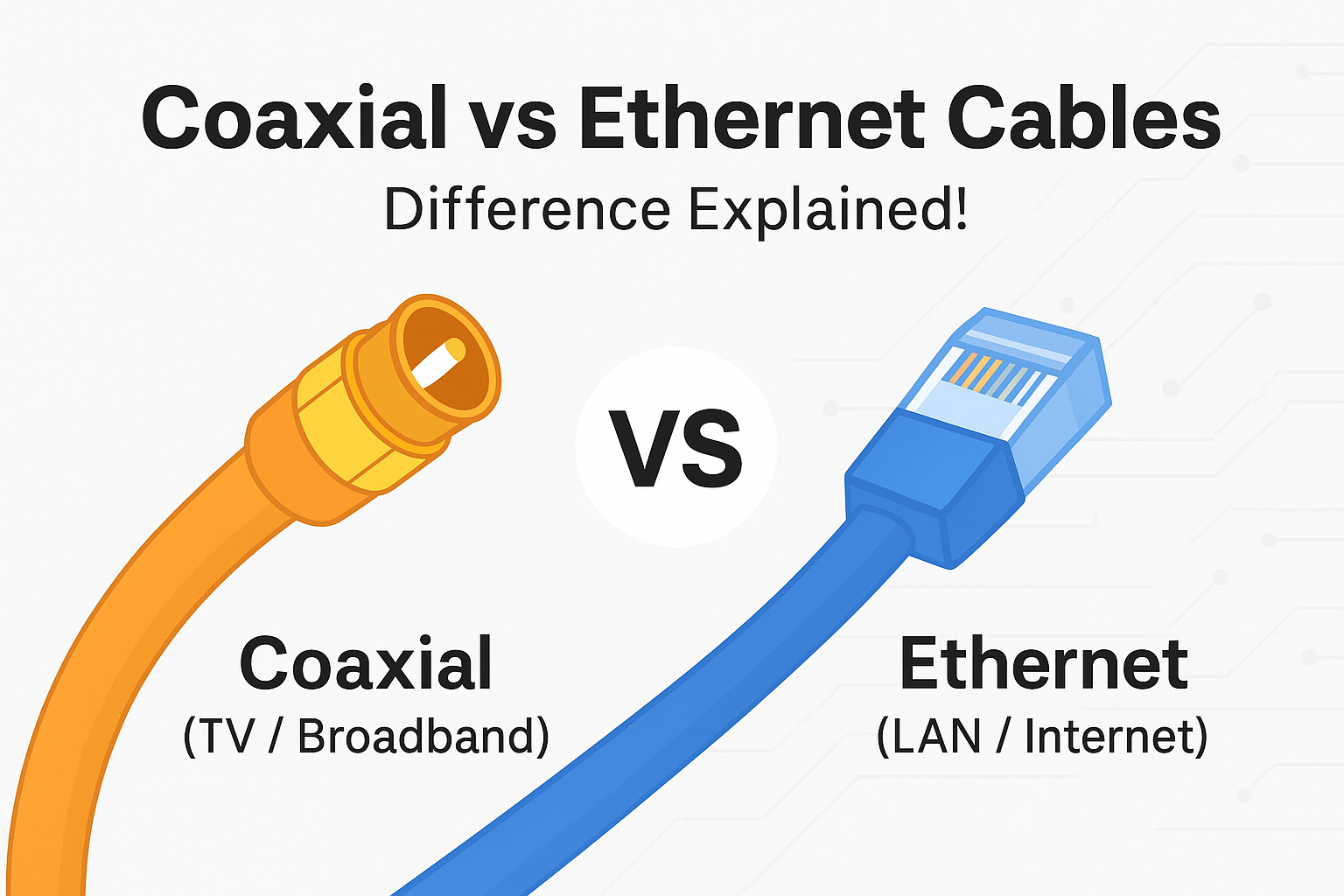Coaxial vs Ethernet Cables – Difference Explained!

Coaxial and Ethernet cables are both low-voltage cables and are used for similar purposes, such as data transmission. But they are built differently and their uses are nuanced. Ethernet Cables feature 8 wires, which are twisted into 4 pairs. This is why these cables are also known as twisted pair cables. Coaxial cables on the other hand, are built using a single copper conductor in the middle. When it comes to the uses of both cables, Coax or Coaxial cables are mostly used to connect TVs with devices. Whereas Ethernet Cables are used to connect computers with routers/modems and with the internet.
In this blog post, we will delve deeper into the difference between Ethernet Cables and Coaxial Cables. We will explore the different Ethernet cables that you can buy, their types, as well as the different options to choose from in Coaxial cables. Moreover, we will explain the different purposes of each and which one you should buy.
What is a Coaxial Cable?
Coaxial cables are low-voltage cables that is used for data transmission, but in a different way. A coax cable is built with a single copper conductor in the middle, which is then surrounded by insulation and shielding to protect the signals from interference. If you are looking for a solution to hook-up your TV with a set-top box or connect a modem with the internet line from your service provider, this is the type of cable you need.
You can either choose RG6, RG59, or RG11. Each of these cables has its own uses, but for most home users, RG6 is the best option. These cables are also commonly used in CCTV camera setups. Moreover, coaxial cables can also be used for broadband internet connections, depending on the ISP.
What is an Ethernet Cable?
As mentioned earlier, an Ethernet cable is a low-voltage cable that is used to transfer data from one computer to another or to the internet and back. An Ethernet cable features 4 twisted pair wires at its core, which are wrapped in a protective sheath known as a jacket.
If you are looking for a solution to hook-up your computer with the modem or router, this is the type of cable you need. You can either choose a Cat5e, Cat6, or a Cat6a. Each of these cables has its own pros and cons, but you can never go wrong with a Cat6 or Cat6a.
These cables can also be used for Power over Ethernet applications. Moreover, Ethernet cables can also be used to set up local area networks (LAN) in offices, etc.
What the common user doesn’t know about Ethernet cables is this: Ethernet Cables offer faster and reliable internet compared to WiFi. Although it is not portable like your WiFi connection but internet over Ethernet cables is much faster.
Key Differences Between Coaxial and Ethernet Cables
Although both coaxial and Ethernet cables are used for data transfer, they are built differently and serve different purposes. Coaxial cables are single-core with shielding, while Ethernet cables are made of 8 wires twisted into 4 pairs. When it comes to speed, Ethernet cables are much faster, capable of 1Gbps to 10Gbps depending on the category.
Coaxial cables are usually limited by the ISP speed and are mostly used for TV and broadband. Ethernet cables are limited in distance (100 meters max), while coax can go much longer without much loss. Connectors are also different: coax uses F-type or BNC, while Ethernet uses RJ45.
| Feature | Coaxial Cable | Ethernet Cable (Twisted Pair) |
| Build / Structure | Single copper conductor in the center with insulation and shielding | 8 copper wires twisted into 4 pairs, wrapped in a jacket |
| Common Use | TV connections, satellite, cable internet, CCTV | Connecting computers, routers, modems, LAN networks |
| Speed | Limited by ISP (100 Mbps – 1 Gbps typical) | 100 Mbps up to 10+ Gbps depending on category (Cat5e, Cat6, Cat7, Cat8) |
| Distance | Can run for several hundred meters with low signal loss | Effective up to 100 meters per cable run |
| Connectors | F-type, BNC | RJ45 |
| Interference | Shielded – less prone to external interference | Twisted pairs reduce crosstalk (shielded versions available for more) |
| Best For | Bringing internet/TV signal to modem or set-top box | Fast, stable device-to-device networking |
Types of Coaxial Cables
There are a few main types of coaxial cables you will come across. RG6 is the most common and is used for TV and broadband internet. RG59 is older, thinner, and mostly used for CCTV or shorter runs. RG11 is thicker and used for longer distances or outdoor installation. Each has the same basic design (single copper conductor with shielding), but the thickness and quality of shielding make them useful for different jobs. For most home internet or TV needs, RG6 is more than enough.
- RG6
- RG59
- RG11
- Hardline Coax
- Tri-Shield RG6
- Quad-Shield RG6
- RG8
- RG213
Types of Ethernet Cables
Ethernet cables are available in different categories. Cat5 is the older type and is now mostly replaced by Cat5e, which supports up to 1Gbps speeds. Cat6 is the most common today and works for 1Gbps easily and up to 10Gbps on shorter runs. Cat6a is an improved version with better shielding for faster and more stable networks. Cat7 and Cat8 are more high-end and are usually used in data centers or enterprise networks. For home and office, Cat6 or Cat6a is usually the best choice.
- Cat5e Ethernet Cable
- Cat6 Ethernet Cable
- Cat6a Ethernet Cable
- Cat7 Ethernet Cable
- Cat8 Ethernet Cable
Which One Do You Need?
If your main purpose is to connect a TV, a cable box, or for CCTV installation, then you will need a coaxial cable. If your purpose is to connect your computer, router, gaming console, or to set up a local network, then an Ethernet cable is the right choice.
In many setups, you actually need both: coax brings the internet from the service provider to your modem, and Ethernet takes that internet from the modem to your devices. So instead of thinking which is better, think which is needed for your setup.
In a Nutshell..
Coaxial and Ethernet cables are both important and widely used. Coax is older but still very reliable for TV and broadband delivery. Ethernet is modern and faster, and is best for networking between devices. The choice is not about one being better than the other, but about what job you need it for. For internet inside your home or office, Ethernet wins. For bringing an internet or TV signal into your home, coax is still the standard.
FAQs
Is coaxial cable better than Ethernet?
No, coaxial cable is not better than Ethernet. Both have different uses. Coaxial is mostly used to bring TV signals or the internet from your service provider to your modem. Ethernet is made for connecting devices inside a home or office. If you want gaming, streaming, or a strong local network, Ethernet is much faster and more stable compared to coax.
Is coaxial cable good for internet?
Yes, a coax cable is good for the internet, but only for a certain part of the job. Your ISP will use coax to bring the internet line to your modem or router. After that, Ethernet cable is what you use to connect your computer, console or other device. That way you get faster and more stable speeds inside your home.
Is coax or Cat5 faster?
Cat5 Ethernet is usually faster than coax. Coax speed depends on your ISP and can go from 100Mbps up to around 1Gbps. Cat5 and Cat5e Ethernet can go up to 1Gbps, and newer types like Cat6 or Cat7 can reach 10Gbps or more. So for modern internet and networking, Ethernet cable is the faster choice.
Is coaxial Ethernet still used?
Coax Ethernet was used in older computer networks (like 10BASE2 or 10BASE5) but it is not used anymore. Now Ethernet cables like Cat5e, Cat6 or Cat7 and also fibre optic cables have fully replaced it. Coax is still around but only for TV and internet signal delivery, not for networking computers.



